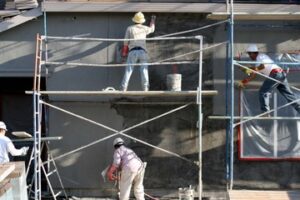Stucco is a beautiful and durable exterior material that adds energy efficiency and insulation to homes. However, it must be inspected and properly maintained to avoid cracking or moisture intrusion.
The stucco process is lengthy, and proper application techniques are essential to a smooth finish. This article will discuss a few key tips and techniques for achieving a great-looking Dryvit Stucco Installation finish.

Preparation
Stucco absorbs moisture, so it needs to be properly installed and maintained to prevent cracking. Cracks may seem like a cosmetic issue at first, but they can cause lasting structural damage to your home. Fortunately, a few simple steps can help prevent these problems and ensure that your stucco is in good condition for years to come.
First, it is important to make sure that the sheathing on your walls is adequate for stucco application. This can be done by examining the sheathing materials and making sure they meet local building codes. It is also important to check for any existing expansion joints in the wall and make sure they are maintained throughout the stucco process. Expansion joints allow for the movement of the wall panels as the temperature changes, preventing the formation of permanent cracks in the stucco.
Next, you must hang a double layer of building paper, starting from the bottom of the wall and overlapping by at least four inches. You should also hang a weep screed at the base of the wall, which creates a sponge-like layer that allows moisture to drain down through the sheathing instead of causing moisture damage in the stud wall. This step is critical to protecting the sheathing from moisture damage, and it should be followed by installing any trim accessories such as corner pieces.
Once the sheathing is in place, it should be sprayed with water to dampen it. This will improve how well the scratch coat adheres to the wall and prevent it from drying too quickly. It is also recommended to use a fog spray to ensure that the entire surface of the wall is evenly wet.
A scratch coat is a mixture of sand and cement that is applied to the lath on your walls. This is essential to ensuring that the brown coat and other stucco applications adhere correctly. It is important to mix the scratch coat with cold water and apply it using a trowel, as hot water can cause it to dry too quickly.
You can also choose to acid etch or sandblast the sheathing before applying the scratch coat. This can be done by hand with a brush or power washer but is best performed by machine. This will roughen the surface of the sheathing, allowing the brown coat and stucco to adhere properly.
Mixing
Stucco is a relatively simple material to install, but a lot of things can go wrong. This is one reason why it’s often best to entrust this type of project to a team of experienced stucco contractors.
Some of the most common issues with stucco are cracks, which can occur for several reasons. These include improper installation, changes in temperature, or the settling of the building. In addition, problems can also arise from poor mixing.
When applying stucco, it’s important to use the proper ratio of materials. This is especially true for the base coat, which must be mixed at the right consistency. If this mix isn’t properly combined, it can lead to clumps that may interfere with the application of the finish coat.
To avoid this issue, it’s important to start with the correct ratio of water to mix. This will ensure that the stucco mixes up correctly and is ready to be applied to the wall. Ideally, it’s best to start with water that is as cool as possible so that the stucco doesn’t dry too quickly.
It’s also important to use the proper amount of sand when mixing the base coat. A good rule of thumb is to use three shovels of sand for every one shovel of mix. This will help to create a smooth and sturdy finished product.
To make sure the sand and stucco are mixed properly, it’s a good idea to invest in a high-quality mortar or barrel mixer. These types of mixers will spin the ingredients to thoroughly combine them and provide a uniform thickness. Alternatively, you can mix your stucco by hand using a wheelbarrow and hoe or a mixing trough.
Once your base coat has been mixed to the right consistency, it’s time to apply the brown or scratch coat. This layer is essential for preventing water from seeping through the wall and causing damage. It’s best to apply this coat with a trowel and wait for it to dry completely before applying the final finish coat.
Applying
Stucco offers a variety of aesthetic benefits for both interior and exterior surfaces. It adds texture, color, and interest to buildings and is a popular choice for homes and commercial structures alike. The process of applying stucco can be complex and time-consuming, but a professional contractor will have the tools, knowledge, and experience to deliver high-quality results.
The first step of any stucco project is to prepare the surface. This involves repairing any cracks, cleaning the surface, and removing any debris that may be present. It is also important to make sure that the wall is properly insulated and has adequate air sealing. This will help reduce energy costs and ensure that the finished product is durable and long-lasting.
After preparing the surface, it is important to ensure that the sheathing and other framing materials are watertight. This will protect the wall from moisture damage and prevent mold growth. For wood-framed walls, this requires the use of a weather-resistant vapor barrier like a layer of grade D building paper or Tyvek drainwrap. For cement board or oriented-strand board sheathing, it is recommended that a drainage plane be created with the addition of a sheet of flashing to provide an extra barrier against moisture.
Once the sheathing and drainage plane are in place, the next step is to apply a scratch coat. This is a mixture of sand and cement that is applied in lines to the lath and then allowed to cure. This is an essential step to ensuring that the brown coat and subsequent layers adhere correctly.
The brown coat is the base of the stucco and it is typically about 1/8 inch thick. This is the layer that will be textured and colored, so it is important to take the time to apply it properly. This can be done by hand or with a power trowel, and different textures are available, including swirls, skip trowels, and the popular Santa Fe style.
Once the brown coat has dried, it is important to allow it to cure completely before continuing with the stucco process. This usually takes two weeks or more, depending on the climate and type of weather. It is also important to make sure that all areas are dry before beginning the application of the stucco. This will ensure that the stucco is not damaged by moisture or rain and will give it a smooth, attractive finish.
Finishing
Stucco is one of the most durable materials for exteriors. It is resistant to water, heat, and sunlight, and withstands changes in climate conditions. It can also reduce a home’s energy costs. However, if not installed correctly, stucco can crack. These cracks are not only unsightly but can damage the integrity of a building. To avoid cracking, you should hire a professional stucco contractor to complete the work.
The modern version of stucco is made using Portland cement, lime, and sand to create a thick paste that dries hard. It is applied in a three-step process, starting with a scratch coat. This is applied to stone or a wood-framed house covered in metal lath. The scratch coat is a mixture of sand and cement and is used to help the brown and final layers bond properly. It is then left to cure before the second and final layer can be applied.
After the brown coat has cured, the finishing stucco is applied to the walls. This is a decorative mix that can include pigments and other additives to create various textures. The stucco is troweled or floated onto the wall, and a texture can be added for aesthetics and ease of cleaning.
It is important to follow the finishing instructions on the bag. The mix should be thin enough that it sticks to the trowel, but not so thin that it will dry out quickly. It is best to apply the finish coat in a cool area, as it will adhere better and will not dry out too quickly. It is also recommended to moisten the surface with a spray bottle of water to prevent it from drying out too quickly.
To prevent the stucco from pulling away from the structure, it is important to install expansion joints and corner trim pieces. You can use galvanized nails or screws to secure these items, and be sure that they are installed correctly. Also, you should install weep screeds at the bottom of all walls. These are needed to allow water to escape and should be placed along the corners, around windows, and doorways.
